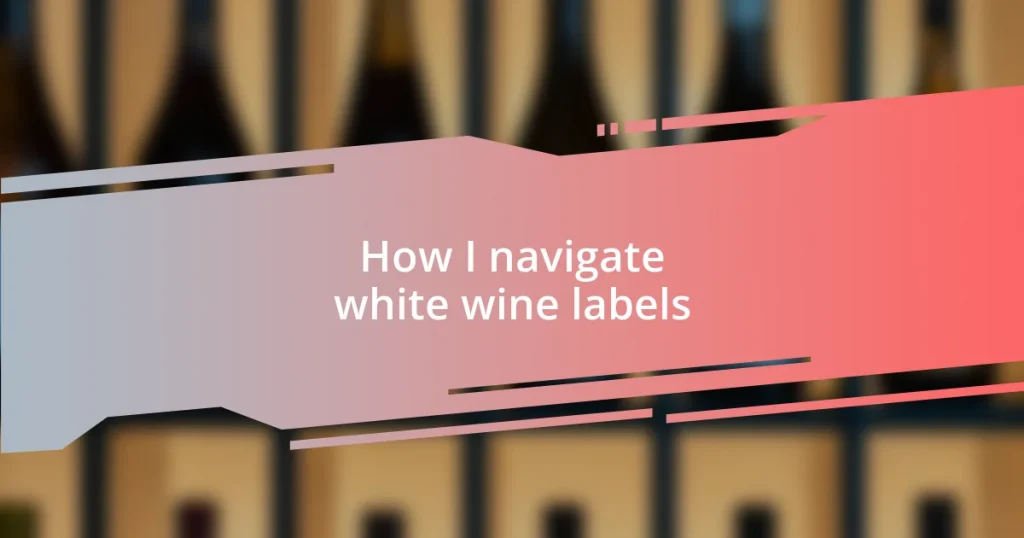Key takeaways:
- Understanding key elements of wine labels such as varietal, region, vintage, and producer influences flavor, quality, and overall wine experience.
- Different white wine varietals offer unique characteristics, with notable examples being Chardonnay, Sauvignon Blanc, Riesling, and Pinot Grigio, enhancing the exploration journey.
- Trusting personal taste and being aware of wine style (dry vs. sweet) can improve wine selection and lead to more enjoyable experiences.
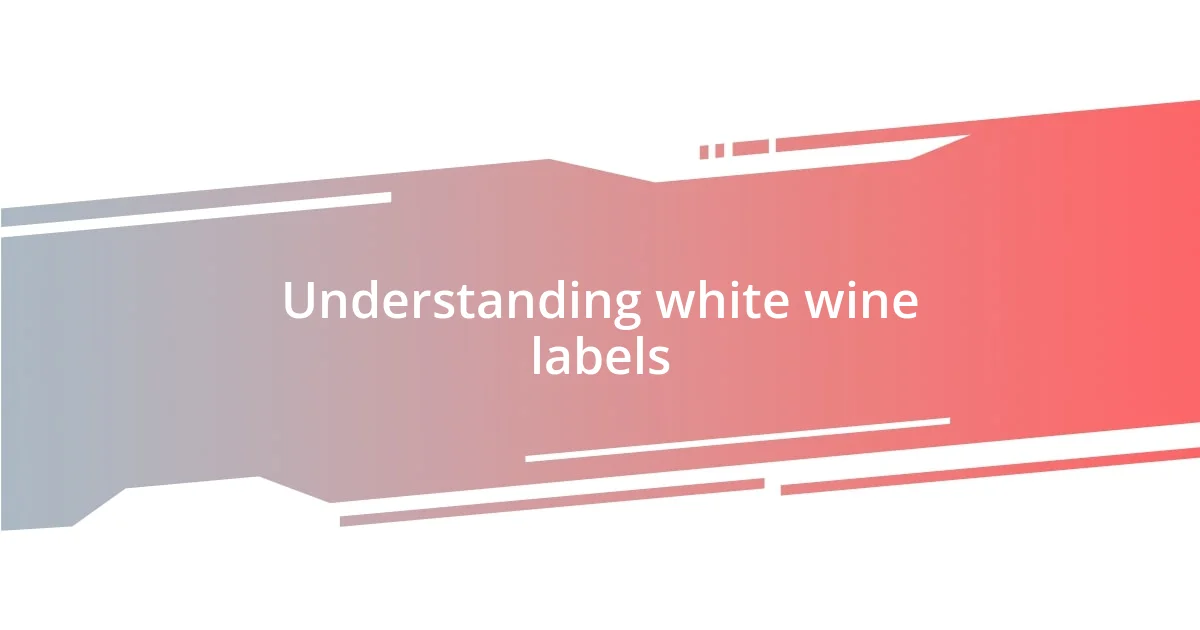
Understanding white wine labels
When I first started exploring white wines, I found labels both intriguing and overwhelming. The variety of terms—like “Chardonnay,” “Sauvignon Blanc,” or “Pinot Grigio”—felt like a new language. Have you ever stood in the wine aisle, feeling lost amidst a sea of bottles, wondering which one is the right choice for your dinner?
As I began to unravel the mysteries of wine labels, I learned that each element provides a clue. For instance, the region can indicate the flavor profile; a French Sancerre made from Sauvignon Blanc will taste quite different from a Californian version. It’s fascinating how geography influences flavor, isn’t it? I remember tasting a crisp, mineral-driven Sauvignon Blanc from the Loire Valley that completely changed my perception of this grape.
Also, don’t overlook the vintage year; it tells you when the grapes were harvested. A particularly good year can lead to exceptional wines, making the vintage an important detail to consider. The more I delved into these nuances, the more I understood how much they could enhance my wine selection experience—almost like a treasure map guiding me to delightful discoveries.
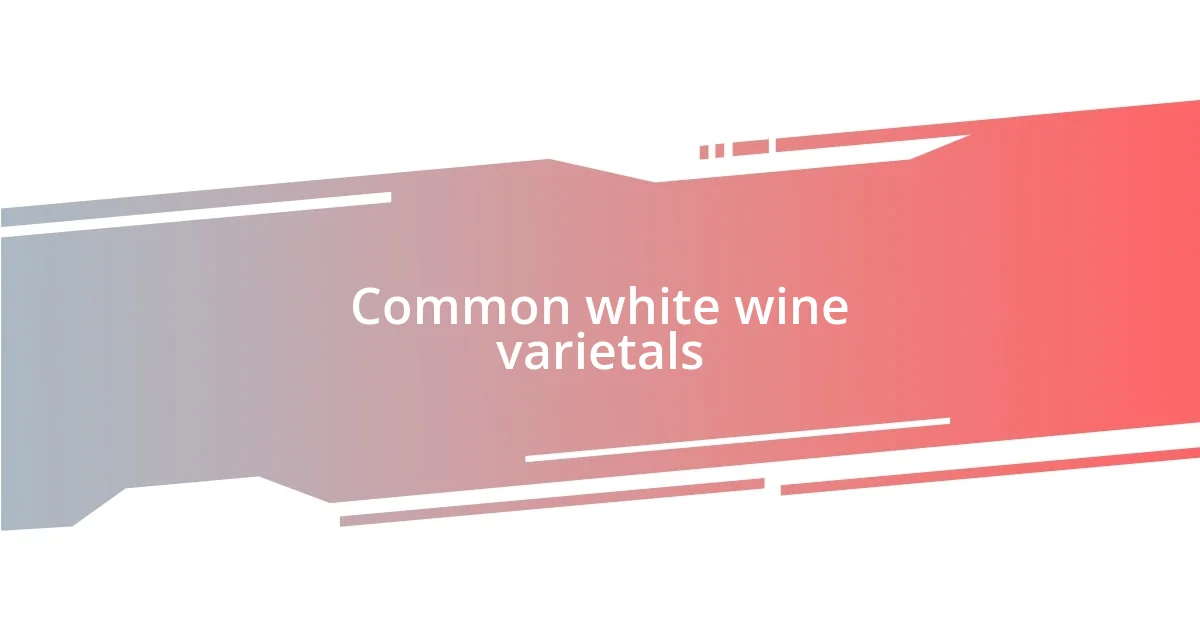
Common white wine varietals
When I think about common white wine varietals, a few standout names come to mind, each with its own unique personality. For instance, Chardonnay is like the chameleon of white wines; it can range from buttery and oaky to crisp and mineral. I still fondly recall a lavishly rich California Chardonnay that paired beautifully with my favorite lobster dish—it was a match made in heaven!
Then there’s Sauvignon Blanc, which tends to pack a zesty punch. It reminds me of sunny afternoons spent picnicking, where I’d sip on a refreshing bottle from New Zealand, bursting with citrus and herbaceous notes. Each varietal has a narrative to tell, and exploring them is like storytelling through wine.
Here are some common white wine varietals and their characteristics:
- Chardonnay: Full-bodied with flavors ranging from apple and pear to buttery and oaky, depending on the winemaking style.
- Sauvignon Blanc: Crisp and refreshing, often exhibiting notes of green apple, lime, and grassy flavors.
- Riesling: Known for its sweetness and aromatic qualities, showcasing flavors of peach, apricot, and floral notes.
- Pinot Grigio: Light and zesty, usually featuring citrus and green fruit flavors, making it a perfect warm-weather choice.
- Gewürztraminer: Highly aromatic and often sweet, with notes of lychee, ginger, and floral characteristics.
Understanding these varietals can truly enrich your wine journey. Each bottle holds the potential for a delightful experience; it just takes a little exploration to find your favorites!
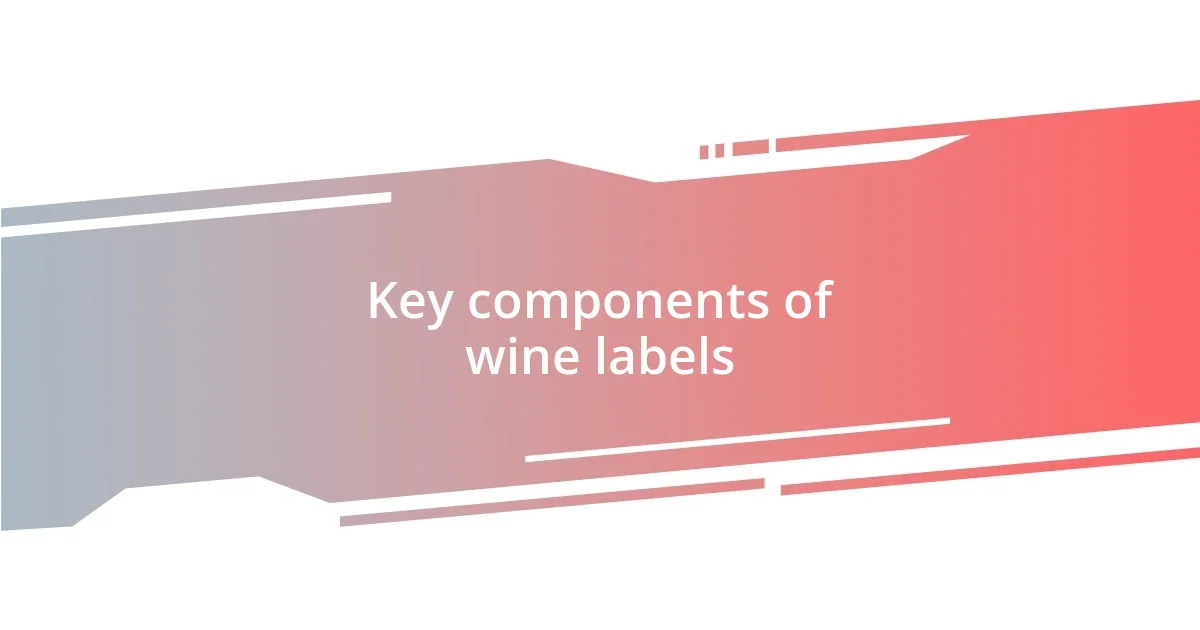
Key components of wine labels
Wine labels are like a window into the winemaking world. They tell a story about where the grapes come from, the varietal used, and sometimes even the winemaker’s philosophy. I remember the first time I noticed the “AOC” designation on a French wine—it’s short for “Appellation d’Origine Contrôlée,” which signifies that the wine meets strict standards reflecting its origins. This was eye-opening for me, showcasing how geography and regulations intertwine to create unique flavors.
Another essential component is the producer’s name, which can significantly influence my purchasing decisions. For years, I’ve gravitated toward certain vineyards. When I spot a wine from a trusted producer, it’s as if I’m meeting an old friend. Just recently, I found a bottle from my favorite winemaker, and I felt that familiar thrill of anticipation, recalling how their wines have consistently delighted my palate.
Vintage can be a make-or-break factor too. A good vintage can transform the quality of the wine, making it more enjoyable. I still have memories of a particularly remarkable white from a stellar vintage—everything from its aroma to its finish was just perfect. Reflecting on these components not only enhances my understanding but also deepens my appreciation for each bottle I choose.
| Key Component | Importance |
|---|---|
| Varietal | Indicates the grape type used, influencing flavor and aroma. |
| Region | Provides insight into wine style and characteristics based on geography. |
| Vintage | Year the grapes were harvested, crucial for assessing quality. |
| Producer | Reflects the winemaker’s style and reputation, which can affect quality. |
| AOC | Indicates strict quality standards in wine production (specific to French wines). |

How to read alcohol content
When I examine a wine label, the alcohol content always catches my eye, typically expressed as a percentage. Have you ever noticed how this number can greatly influence your choice? For example, I remember sipping a lovely Sauvignon Blanc, and I was pleasantly surprised to find it at 12.5% alcohol. This lower level made it refreshing and perfect for my warm summer afternoon.
Understanding alcohol content is essential—it gives you insight into the wine’s strength and how it might affect your experience. A wine with higher alcohol content, say around 14.5%, tends to feel bolder and more full-bodied. I often think about a zesty Riesling with 10% alcohol; its lighter nature allowed me to enjoy several glasses without feeling overwhelmed. It’s fascinating how a mere percentage can shape the flavors and mellowness of each sip.
I’ve learned that if I’m having a vibrant dish, like grilled shrimp, I gravitate towards wines with lower alcohol content for an enjoyable pairing. This balance not only enhances my meal but also ensures I stay refreshed throughout the evening. It’s all about reading that little percentage and appreciating how it complements the overall experience!
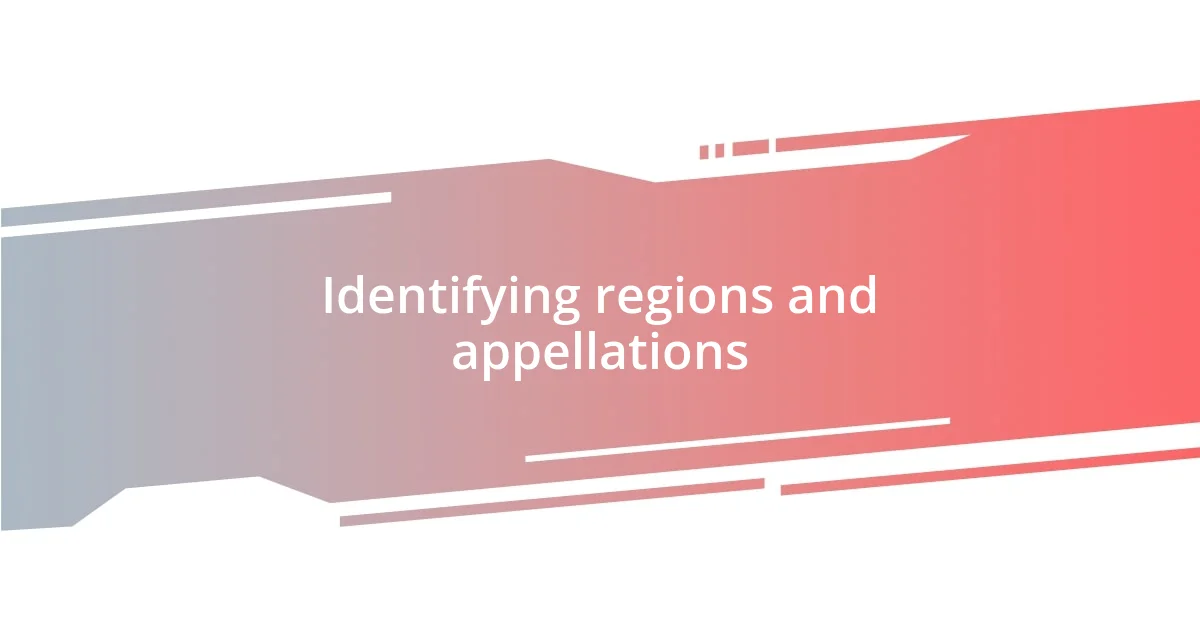
Identifying regions and appellations
When I dive into the world of wine, identifying the region and appellation is like embarking on a thrilling treasure hunt. Each region, whether it’s the sun-kissed vineyards of California or the rolling hills of Tuscany, offers unique characteristics shaped by climate, soil, and winemaking traditions. I vividly remember tasting a lovely Pinot Grigio from the Veneto region; its bright acidity and floral notes seemed to echo a sunny day spent wandering among the vineyards. Isn’t it amazing how geography can impart such distinct flavors to a wine?
The appellation is just as important as the region itself. While exploring French wines, I learned that the “Côte d’Or” appellation signifies a specific area within Burgundy known for its exceptional Pinot Noir and Chardonnay. This information not only piqued my interest but also guided my choices when seeking quality wines. I recall once selecting a bottle purely based on its Bourgogne designation and was met with a delightful surprise—each sip transported me deeper into the nuances of this cherished wine-producing area.
Additionally, understanding these labels can also open up new avenues to explore. I often find myself asking, “What else can I discover within this appellation?” Once, after enjoying a crisp white from Marlborough, I decided to seek out other wines from this region. The experience was rewarding, as I began appreciating the broad spectrum of flavors—from citrusy Sauvignon Blancs to elegant Chardonnay. It’s fascinating how a closer look at regions and appellations can turn a simple bottle search into a delightful adventure!

Notes on vintage and quality
When it comes to vintage, I’ve found that it can significantly impact the quality and character of a white wine. For instance, I remember eagerly opening a bottle of 2016 Chardonnay, which had been praised for its exceptional growing season. The complex flavors of ripe fruit and subtle oak reminded me why I love exploring wines from certain years. Have you ever been surprised by how a specific vintage can elevate your tasting experience?
Quality often intertwines with vintage, showcasing the skill of the winemaker and the conditions that influenced the grapes. I once stumbled upon a 2018 Sauvignon Blanc that caught my attention—not only because of its vibrant label but also because I had heard great things about that year in New Zealand. As I poured a glass, the crisp acidity and lively notes danced on my palate, reaffirming my appreciation for the way vintage can shape a wine’s profile.
I’ve also learned to pay attention to the reputation of the vintage on the label. It can be a game changer in making informed choices. For example, when I came across a 2020 white from Burgundy, I was hesitant, having read mixed reviews about that year. Ultimately, my curiosity led me to purchase it, and I was thrilled to discover a beautifully crafted wine that defied expectations. Isn’t it rewarding when a little exploration turns into a delightful surprise?

Tips for selecting white wine
Selecting white wine can truly feel like an art form, and one of my favorite tips is to look for the grape variety on the label. I once grabbed a bottle labeled “Vinho Verde” purely out of curiosity. That first sip unleashed a wave of zesty citrus and effervescence that was both refreshing and invigorating. Do you have a grape variety you tend to gravitate towards? By knowing which grapes you enjoy, you can streamline your choices and embark on a more satisfying journey through the aisles.
Understanding the style of wine is equally important. I often spot wines marked as “dry” or “sweet,” which can drastically affect my expectations. I recall picking up a Muscat thinking it would be an aromatic, dry treat, only to discover it had a luscious sweetness which caught me off guard. Have you ever misjudged a wine based on its label? Examining the style can save you from disappointment and lead you to exactly what you’re craving, whether it’s a crisp, chilled glass for a summer’s day or something richer for a cozy evening.
Lastly, don’t forget to trust your own palate. I once entrusted a sommelier’s recommendation, opting for an obscure white wine that was highly praised. While it was undeniably interesting, it didn’t resonate with my taste buds. This experience taught me that personal preference reigns supreme—what works for someone else might not work for you. So, next time, consider following your instincts; they often lead you to delightful surprises that feel true to your tastes!










